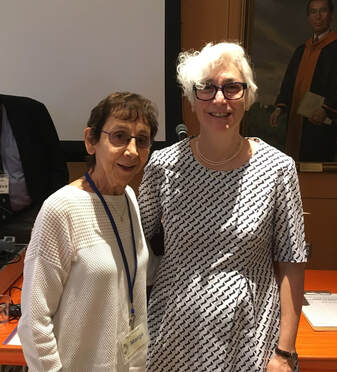September 11, 2019
The Dutch Gift: 2017 Edition
Ronni Baer
Distinguished Curator and Lecturer, Princeton University Art Museum
Minutes of the First Meeting of the 78th Year
President Julia Coale called the first meeting of the 78th year of the Old Guard of Princeton to order. Julie Denny led the invocation, and Jane Silverman read minutes from the May 22nd meeting. A moment of silence was observed for deceased members Tom Buzard, Henry Powsner, and Harvey Rothberg. Ms. Coale reminded members that the annual dues are due and urged attendees, of which there were 135, to consider joining the AV Committee chaired by Dan van Kammen, who introduced his wife, Welmoet van Kammen as a special guest.
Marge D’Amico introduced the guest speaker, Ronni Baer, who has the title of Distinguished Curator and Lecturer at Princeton University Art Museum, a title earned through her scholarship and association with the acquisition of a very special gift to the Museum of Fine Arts in Boston. Her presentation is entitled "The Dutch Gift."
Ms. Baer began the talk by explaining the very important relations between a museum and its private art collectors and patrons. The relationship is crucial for the acquisition of new works and the principle means of expanding the collection and thereby making the works available for public view.
Such was the case when two families agreed to donate their collections of 17th century Dutch and Flemish art to the Museum of Fine Arts (MFA). The donation from the Van Otterloo and Weatherbie families was the largest in the museum’s history and created one of the foremost collections of Dutch art available worldwide. The gift of 113 works by 76 artists includes some by recognized masters such Rembrandt, Peter Paul Rubens, Leiden artists, and many others that had not been seen outside the region.
She then led us through a slide presentation of the gift, a collection of paintings in all styles and genres that give insight into 17th century Dutch life. We viewed portraits, genre scenes, landscapes, seascapes, still lifes, floral pictures, seascapes, and rare architectural pieces.
Ms. Baer’s research and curative skill was evident as she shared insightful comments about the works in the collection that might not be apparent to the average viewer. Portraits of aristocrats with dark backgrounds in accordion collars were compared with whimsical real life faces inserted in historical and mythological paintings. Exquisite landscapes were carefully rendered "en plein air," although research indicates the expressive cloud formations in them do not exist as rendered. Monochromatic still life paintings were executed with precision and detail. A wine glass in reflected light seems too delicate to touch. Seascapes appear animated though expressive bush strokes. Cityscapes and interior paintings are so carefully rendered they are often used as reference for contemporary restoration projects.
Time did not permit a question and answer period. However, Ms. Baer did share that her work in Princeton will be teaching, research, and restoration of the Princeton Art Museum's European collection. She urged the audience to watch for announcements about opportunities to view works from “The Dutch Gift” when the new museum opens in 2024.
Respectfully submitted,
Benjamin J. Colbert
Marge D’Amico introduced the guest speaker, Ronni Baer, who has the title of Distinguished Curator and Lecturer at Princeton University Art Museum, a title earned through her scholarship and association with the acquisition of a very special gift to the Museum of Fine Arts in Boston. Her presentation is entitled "The Dutch Gift."
Ms. Baer began the talk by explaining the very important relations between a museum and its private art collectors and patrons. The relationship is crucial for the acquisition of new works and the principle means of expanding the collection and thereby making the works available for public view.
Such was the case when two families agreed to donate their collections of 17th century Dutch and Flemish art to the Museum of Fine Arts (MFA). The donation from the Van Otterloo and Weatherbie families was the largest in the museum’s history and created one of the foremost collections of Dutch art available worldwide. The gift of 113 works by 76 artists includes some by recognized masters such Rembrandt, Peter Paul Rubens, Leiden artists, and many others that had not been seen outside the region.
She then led us through a slide presentation of the gift, a collection of paintings in all styles and genres that give insight into 17th century Dutch life. We viewed portraits, genre scenes, landscapes, seascapes, still lifes, floral pictures, seascapes, and rare architectural pieces.
Ms. Baer’s research and curative skill was evident as she shared insightful comments about the works in the collection that might not be apparent to the average viewer. Portraits of aristocrats with dark backgrounds in accordion collars were compared with whimsical real life faces inserted in historical and mythological paintings. Exquisite landscapes were carefully rendered "en plein air," although research indicates the expressive cloud formations in them do not exist as rendered. Monochromatic still life paintings were executed with precision and detail. A wine glass in reflected light seems too delicate to touch. Seascapes appear animated though expressive bush strokes. Cityscapes and interior paintings are so carefully rendered they are often used as reference for contemporary restoration projects.
Time did not permit a question and answer period. However, Ms. Baer did share that her work in Princeton will be teaching, research, and restoration of the Princeton Art Museum's European collection. She urged the audience to watch for announcements about opportunities to view works from “The Dutch Gift” when the new museum opens in 2024.
Respectfully submitted,
Benjamin J. Colbert

